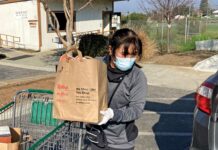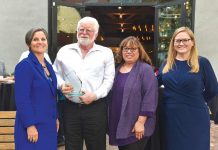As the skies begin to open up and bless us with some rain, the reality is that our water supplies are so depleted that even a normal rain year would not be enough to end our local drought conditions. So we will all need to continue the water saving practices we have started. If it’s another dry year, we will need to save even more.
While we had a bit of rain in October, most of our annual rainfall comes in the winter months. On Nov. 1, the rain gauge in downtown San Jose had registered just .91 inches since July 1. The season average in that spot is 14.3 inches. We have a long way to go to even reach a normal level of rain.
In fact, with the hills as dry as they are, the most recent storm runoff was quickly absorbed by thirsty soils and did not produce any measurable run-off into our local reservoirs. They remain at less than one-third of full capacity. Four reservoirs—Chesbro, Uvas, Guadalupe and Stevens Creek—are less than 10 percent full after three years of drought.
The cooler temperatures and shorter days that come in winter are enough for most people to cut down on their outdoor watering; your irrigation should be cut to one third of its summer schedule. By winter, you should shut down all irrigation until the spring.
While we have regionally achieved a 12 percent reduction in water use this year, the result of not reaching our 20 percent water reduction target in 2014 is that our groundwater storage is being depleted. Due to our comprehensive water supply planning efforts, we started 2014 with groundwater storage in the normal range, even as we were experiencing a third very dry year. The beginning of 2015 will not be so rosy. While we started 2014 with about 340,000 acre-feet of stored groundwater (about a year’s supply), 2015 will likely begin with less than 250,000 acre-feet. This takes us into the “severe” stage, the third stage in our five-stage water storage contingency plan.
One disturbing comment I’ve heard more than once is, “I don’t need to conserve, I’m on a well.” The reality is that even though a resident may be on a well, the groundwater levels are dropping, in some places as much as 30 feet. Let’s not fall into the trap of feeling that because you can’t see the water table, you don’t need to conserve. The district has recharged our aquifers with very precious imported water in most cases and if it’s wasted, we may not be able to replenish it.
The statewide picture is no more encouraging. Jeanine Jones, interstate resources manager for the state Department of Water Resources, estimates that California needs 150 percent of normal rainfall to fill up its reservoirs. As the winter progresses, our water supply managers will be watching the Sierra snowpack, and eagerly awaiting projections of how much imported water we can expect next year from the State Water Project and the Central Valley Project. That’s water managed by the state and federal governments that we bring in from outside our county. In a typical year, about 40 percent of our county’s water supply comes from those two sources. In 2014, only a fraction of our normal supply was available.
But it’s not all doom and gloom. The good news is that we have seen some improvements in water use reductions over the last few months. Our county reduced water use by 14 percent in August and September compared to the year before. That’s a better result than we achieved in June (8 percent) or July (11 percent), and is getting us closer to our 20 percent target.
We appreciate the hundreds of people who have called our drought hotline at (408) 630-2000, used our dr*****@*********er.org email or used our Access Valley Water online application to report water waste. Our team of water waste inspectors is out in the community every week helping to educate residents and businesses on how to stop wasting water.
We are hopeful that county water users will continue the good habits they have started. We have continued our increased water conservation rebates until the end of 2014. Find out how these programs can help residents and businesses save water and money at save20gallons.org.
Submitted on behalf of the Santa Clara Valley Water District. For further information, contact Dennis Kennedy via email at dk******@*********er.org or call (408) 265-2600.













